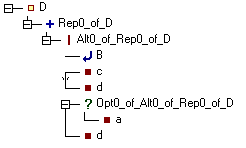User interface > Debugging and executing > Syntax tree
When a start rule was parsed, it will be displayed together with its sub-rules in a syntax tree. By a pop-up menu breakpoints can be set at tree nodes or accompanying first sets can be shown.
At first the productions appear in collapsed form.
Collapsed form

In the collapsed form only the names of the productions are shown, precede by a plus symbol '+'. (If the productions aren't parsed, the plus '+' is absent.)
Expanded Form
In expanded form the names are preceded by a minus '-' and below of the name the sequence of sub-structures is displayed.
Node icons
Each node of the tree is preceded by a little icon, which characterizes the type of the node. The names of the nodes are preceded by a prefix, which also denotes the type.
Icon |
Type |
Prefix |
|
|
|
|
with local options |
|
|
Call of a production |
NT |
|
Terminal symbol = Token |
T |
|
ANY |
|
|
SKIP |
|
|
Alt |
|
|
Opt |
|
|
Rep |
|
|
OptRep |
|
|
Count |
|
|
If |
|
|
Cond |
|
|
Br |
|
|
Sem |
Concatenation
Parts of a production, which follow each other, will be displayed one beneath the other, conjunct by a vertical line with little arrows. A production
A = a b c d
will be displayed as follows

Alternatives
For parts of a rule, which are alternative, an extra node is inserted, and beneath this node the alternatives are displayed as discrete nodes. A production:
A = a | b | c | d
will be displayed as follows

The name of the node, which combines the alternatives is constructed by the prefix "Alt_", a counter and "_of_", followed by the name of the superior node. From the name you can reconstruct the type and position of a node inside of the whole grammar.
Options and repeats
For options or repeats an extra node is constructed. The child node of the latter is that, what is optional or will be repeated. The production:
B = ( b )+
is displayed as follows
![]()
The name of an option node or a repeat node is constructed analogous to the name of an alternative node. The following expressions are used:
Opt for options
0ptRep for optional repeats
Rep for repeats
Semantic actions
At positions, where semantic actions are executed inside of a production, in the syntax tree simple nodes are displayed. The names of the nodes are constructed from "_Sem", a counter and the name of the superior production. Actions, which are directly combined with a token are not displayed.
Complex example
If one of a group of alternatives consists itself of a sequence of token and productions, this sequence is displayed as a sequence of connected nodes. The whole sequence of this alternative is separated from the other alternatives.
Example:
D = (B | c d | ( a )? d )+
would be displayed in the syntax tree as:
